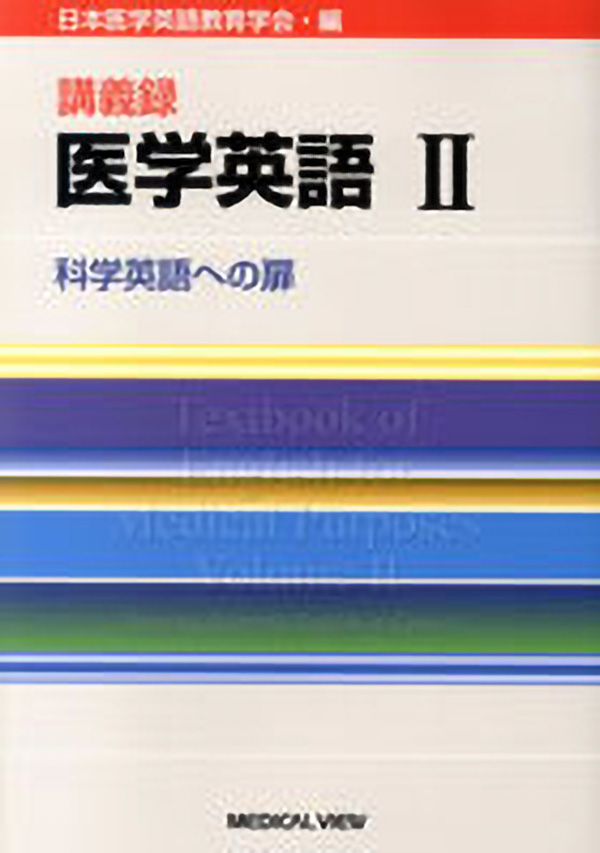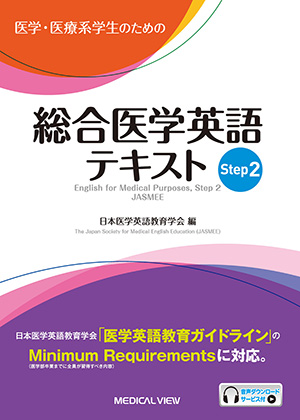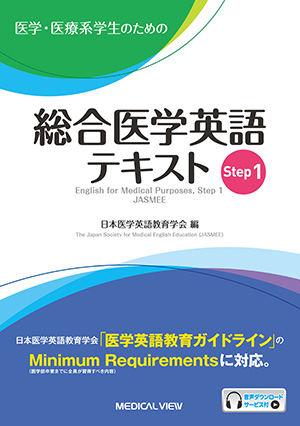講義録
医学英語 II
科学英語への扉

定価 2,750円(税込) (本体2,500円+税)
- B5判 164ページ 2色
- 2005年12月12日刊行
- ISBN978-4-7583-0408-5
序文
第1巻『講義録 医学英語I』に続いて,第2巻の刊行にあたりどのような教材が学習者に「医学英語」の特徴を伝えられるか,また「医学英語」を担当する先生方のニーズに応えられるか考えました。「医学英語」とは一般の英語と何が違うのでしょう。語彙が違うことは第1巻の専門用語で学びましたが,その他には? 表現方法や科学的な論文の構成も一般の読みものとはかなり違います。学習者にはもちろん,医学を専門としない英語教師,あるいは逆に専門の英語表現に触れる機会が多く一般的な表現に馴染みの少ない医師にとっても必要な情報を盛り込んだ教材とはどのようなものか,いろいろ考えた末,一般の英語(general English)と科学/医学で使われる英語(scientific English)の違いを示すことをこの本の特徴にしました。したがって,この第2巻の前半の章はまず専門書ではなくTIME誌やVoice of America(VOA),National Public Radio(NPR)等の一般的なもののなかから医学に関連する題材を採り上げて,そのなかで科学英語との相違点を紹介し,後半の章では専門の論文,症例報告のなかで一般英語との相違点を示すように構成しました。
Chapters 1〜3:一般誌の医学関連記事を読む
Chapters 4〜6:一般の医学関連ニュースを聴き取る
Chapters 7〜10:医学論文の読み方
Chapters 11〜12:症例を読む
各章には,学習者の理解を深めるために詳細な説明を加え,また学習を確実なものにするために練習問題をたくさん用意しました。しかし各章の練習問題は必ずしも全てをやっていただく必要はなく,このテキスト を使用されるそれぞれの状況によって取捨選択していただければ結構です。
後半の医学英語の専門に入って最初の医学論文の読み方の章では数ページにわたる英語の論文のポイントをごく短時間で把握できる方法がわかり,さらにそれが身につくよう練習問題が用意されています。学習者の皆さんにとってはもちろんですが,教師,医師の専門家にも大いに役立つと確信しています。この本で一般英語と科学英語/医学英語の違いを認識し,それが医学英語の理解をより深める一助になることを心から願っています。
最後に,本書の発刊にあたり,辛抱強く見守り,編集・校正に多大な御尽力を頂きました日本医学英語教育学会事務局の江口潤司様に心より御礼申し上げます。
2005年11月
『講義録 医学英語II』編集委員
浜松医科大学 総合人間科学講座(英語)
菱田 治子
------------------------------
To the Student
One purpose of this book is to help you reach your goals. Another is to help you keep up with new diseases, new treatments, and new techniques after you graduate. Some medical universities tell the students, “Most of what you learn in med school will be old by the time you graduate.”
After graduation, you will need all the skills you master in med school today plus good communication skills to use in search of clinical evidence (臨床的根拠の探求) tomorrow. For that reason, this book asks brave questions. For example, in heart patients, do statins work for everybody, or is surgery better? Is aspirin better? As the first-step in managing high blood pressure, are the new expensive drugs really better than a diuretic? In students with McArdleユs disease, how can muscle injury be reduced; how can kidney failure be prevented?
To get the most out of this book:
1. Ask questions,
2. Write notes in the margin,
3. Underline key points,
4. Look for opposite ideas,
5. Look for relationships and patterns,
6. Number the points mentioned in a series.
With these skills, you can think in a more analytical way and interpret the data more quickly. Knowing the four sections of the medical research paper, you can become an expert on what to look for and where to find it in ANY research paper. This will give you an edge in your search for clinical evidence and put you more in command of the information you are reading.
Nell Kennedy, PhD
Professor, Biomedical English
School of Veterinary Medicine
Rakuno Gakuen University
Chapters 1〜3:一般誌の医学関連記事を読む
Chapters 4〜6:一般の医学関連ニュースを聴き取る
Chapters 7〜10:医学論文の読み方
Chapters 11〜12:症例を読む
各章には,学習者の理解を深めるために詳細な説明を加え,また学習を確実なものにするために練習問題をたくさん用意しました。しかし各章の練習問題は必ずしも全てをやっていただく必要はなく,このテキスト を使用されるそれぞれの状況によって取捨選択していただければ結構です。
後半の医学英語の専門に入って最初の医学論文の読み方の章では数ページにわたる英語の論文のポイントをごく短時間で把握できる方法がわかり,さらにそれが身につくよう練習問題が用意されています。学習者の皆さんにとってはもちろんですが,教師,医師の専門家にも大いに役立つと確信しています。この本で一般英語と科学英語/医学英語の違いを認識し,それが医学英語の理解をより深める一助になることを心から願っています。
最後に,本書の発刊にあたり,辛抱強く見守り,編集・校正に多大な御尽力を頂きました日本医学英語教育学会事務局の江口潤司様に心より御礼申し上げます。
2005年11月
『講義録 医学英語II』編集委員
浜松医科大学 総合人間科学講座(英語)
菱田 治子
------------------------------
To the Student
One purpose of this book is to help you reach your goals. Another is to help you keep up with new diseases, new treatments, and new techniques after you graduate. Some medical universities tell the students, “Most of what you learn in med school will be old by the time you graduate.”
After graduation, you will need all the skills you master in med school today plus good communication skills to use in search of clinical evidence (臨床的根拠の探求) tomorrow. For that reason, this book asks brave questions. For example, in heart patients, do statins work for everybody, or is surgery better? Is aspirin better? As the first-step in managing high blood pressure, are the new expensive drugs really better than a diuretic? In students with McArdleユs disease, how can muscle injury be reduced; how can kidney failure be prevented?
To get the most out of this book:
1. Ask questions,
2. Write notes in the margin,
3. Underline key points,
4. Look for opposite ideas,
5. Look for relationships and patterns,
6. Number the points mentioned in a series.
With these skills, you can think in a more analytical way and interpret the data more quickly. Knowing the four sections of the medical research paper, you can become an expert on what to look for and where to find it in ANY research paper. This will give you an edge in your search for clinical evidence and put you more in command of the information you are reading.
Nell Kennedy, PhD
Professor, Biomedical English
School of Veterinary Medicine
Rakuno Gakuen University
全文表示する
閉じる
目次
Part 1 Reading Medical Features in News Magazines
Chapter 1 What Is a Headache?
Reading
Word Study
■migraineur
■keeping their headaches at bay
■biofeedback
Grammatical Points
■倒置による,文の一部の強調(強調される語句が文頭に出てくるため語順が入れ替わる)
■過去分詞句,that節がともに一つの名詞を修飾する
Scientific English
■トピック文("umbrella sentence")の順番とその後の説明の順番を一致させる
■self-contained: 自己限定〔性〕の(self-limited)
Exercises
Chapter 2 The Migraine Mechanism
Reading
Grammatical Points
■先行詞と離れたthat節
■動詞が2つの that節を目的語としている
■不定詞:allow ... to 〜(許可),cause ... to 〜(原因)
Scientific English
■suggestの使い方
Exercises
Scientific English
■Afferent nerves
■Efferent nerves
Exercises
Chapter 3 Rethinking Treatments for the Heart
Reading
Word Study
■the best bet
■fatty plaque, fatty deposit
Scientific English
■短縮形(don't, isn't, can't, you'd)
■人称代名詞(they, you, we, them)
■already
■of course
■seemed
■人以外の所有格
Exercises
Part 2 Listening to Medical News Reports
Chapter 4 Drugs for High Blood Pressure
Exercises
For Further Study
Chapter 5 The Battle between HIV and Antibodies
Exercises
For Further Study
Chapter 6 Drug to Stop Progression of Type 1 Diabetes
Exercises
For Further Study
Part 3 Reading the Medical Research Paper
Chapter 7 Entering the Medical Research Paper
Lecture: 医学論文入門/Title
Exercises
Lecture: What the Abstract can and cannot do 抄録の役割/Reading warm-up
■Abstract
■Underline key words
■Number the points from the known to the unknown
Exercises
Lecture:Pre-reading 準備体操/Entering the Main Body of the Paper/The Research Problem
Exercises
For Further Study:Finding other papers and books for doctors/Using the Internet to contact patients with McArdle's disease
Chapter 8 Reading the Introduction
Reading:The Effect of Oral Sucrose on Exercise Tolerance in Patients with McArdle's Disease/Introduction
Lecture:Clues and Patterns
A specific gap, or unknown, in medical knowledge is a clue to the authors' research aims
Exercises
Lecture:What kinds of information are usually in the Introduction?
Exercises
Lecture:Is the author's argument logical and convincing?
Exercises
For Further Study:See the sucrose drink
Chapter 9 Methods・Results
Reading:Methods
Lecture:Types of study designs
■single-blind(単盲検)
■randomized(無作為化)
■placebo-controlled(プラセボ対照)
■crossover(クロスオーバー)
Exercises
Lecture:What main information is in the Methods section? −Who, What, When, Where, How
■WHO
■WHAT
■Approval by the Ethics Committee
■Informed Consent
■WHEN, WHERE, and HOW
■Analysis
Exercises
Reading:Results
Lecture:What main information is in the Results section?
■The bare data
■Visual comparison
■Statistics
Exercises
For Further Study:A quick guide
Chapter 10 Discussion
Reading:Discussion
Lecture:Clues to Reading the Discussion
■過去形の動詞
■現在形の動詞
Exercises
Lecture:What is the function of the Discussion?
■Discussionの役割
■What questions should we ask?
Exercises
For Further Study
Exercises
Part 4 Reading the Case Report
Chapter 11 Case Report: A 33-year-old Woman with Abdominal Pain, Vomiting, and Erythema
Lecture:The formal case report
Reading:Case report
Lecture:-ectomy / -tomy / -stomy /Visual acuity: 視力の表記/Prescriptions: 処方箋の書き方/Third decadeの和訳/Percent of increase: ○%増加
Exercises
Lecture:Why are 4 criteria necessary for a diagnosis of SLE?
Exercises
For Further Study:I heard that foreign universities do not use ○and ×. Is that true?/What is the difference between an oral case report and a published case report?
Chapter 12 Case Report: A 53-year-old Woman with Sudden Onset of Double Vision
Reading:Case report
Exercises
Lecture:What can we expect from a Case Report?
■Key feature
■Message for the reader
■Message type A
■Message type B
■Chronological structure of published Case Reports
■Do Case Reports count as research?
Exercises
Lecture:「死亡する」という場合の前置詞/Two or moreとmore than two/人名の発音
Exercises
Appendix: Training to Listen like a Scientist
In search of clinical evidence 臨床的根拠の探求
COLUMN
VOA Special Englishについて
VOA Newsについて
NPRについて
お薦めのリスニング・インターネット無料サイト
Informal Messages from Patients with McArdle’s Disease
Finding the Unknown
Autosomal Recessive Genetic Disorder
Specializing
Chapter 1 What Is a Headache?
Reading
Word Study
■migraineur
■keeping their headaches at bay
■biofeedback
Grammatical Points
■倒置による,文の一部の強調(強調される語句が文頭に出てくるため語順が入れ替わる)
■過去分詞句,that節がともに一つの名詞を修飾する
Scientific English
■トピック文("umbrella sentence")の順番とその後の説明の順番を一致させる
■self-contained: 自己限定〔性〕の(self-limited)
Exercises
Chapter 2 The Migraine Mechanism
Reading
Grammatical Points
■先行詞と離れたthat節
■動詞が2つの that節を目的語としている
■不定詞:allow ... to 〜(許可),cause ... to 〜(原因)
Scientific English
■suggestの使い方
Exercises
Scientific English
■Afferent nerves
■Efferent nerves
Exercises
Chapter 3 Rethinking Treatments for the Heart
Reading
Word Study
■the best bet
■fatty plaque, fatty deposit
Scientific English
■短縮形(don't, isn't, can't, you'd)
■人称代名詞(they, you, we, them)
■already
■of course
■seemed
■人以外の所有格
Exercises
Part 2 Listening to Medical News Reports
Chapter 4 Drugs for High Blood Pressure
Exercises
For Further Study
Chapter 5 The Battle between HIV and Antibodies
Exercises
For Further Study
Chapter 6 Drug to Stop Progression of Type 1 Diabetes
Exercises
For Further Study
Part 3 Reading the Medical Research Paper
Chapter 7 Entering the Medical Research Paper
Lecture: 医学論文入門/Title
Exercises
Lecture: What the Abstract can and cannot do 抄録の役割/Reading warm-up
■Abstract
■Underline key words
■Number the points from the known to the unknown
Exercises
Lecture:Pre-reading 準備体操/Entering the Main Body of the Paper/The Research Problem
Exercises
For Further Study:Finding other papers and books for doctors/Using the Internet to contact patients with McArdle's disease
Chapter 8 Reading the Introduction
Reading:The Effect of Oral Sucrose on Exercise Tolerance in Patients with McArdle's Disease/Introduction
Lecture:Clues and Patterns
A specific gap, or unknown, in medical knowledge is a clue to the authors' research aims
Exercises
Lecture:What kinds of information are usually in the Introduction?
Exercises
Lecture:Is the author's argument logical and convincing?
Exercises
For Further Study:See the sucrose drink
Chapter 9 Methods・Results
Reading:Methods
Lecture:Types of study designs
■single-blind(単盲検)
■randomized(無作為化)
■placebo-controlled(プラセボ対照)
■crossover(クロスオーバー)
Exercises
Lecture:What main information is in the Methods section? −Who, What, When, Where, How
■WHO
■WHAT
■Approval by the Ethics Committee
■Informed Consent
■WHEN, WHERE, and HOW
■Analysis
Exercises
Reading:Results
Lecture:What main information is in the Results section?
■The bare data
■Visual comparison
■Statistics
Exercises
For Further Study:A quick guide
Chapter 10 Discussion
Reading:Discussion
Lecture:Clues to Reading the Discussion
■過去形の動詞
■現在形の動詞
Exercises
Lecture:What is the function of the Discussion?
■Discussionの役割
■What questions should we ask?
Exercises
For Further Study
Exercises
Part 4 Reading the Case Report
Chapter 11 Case Report: A 33-year-old Woman with Abdominal Pain, Vomiting, and Erythema
Lecture:The formal case report
Reading:Case report
Lecture:-ectomy / -tomy / -stomy /Visual acuity: 視力の表記/Prescriptions: 処方箋の書き方/Third decadeの和訳/Percent of increase: ○%増加
Exercises
Lecture:Why are 4 criteria necessary for a diagnosis of SLE?
Exercises
For Further Study:I heard that foreign universities do not use ○and ×. Is that true?/What is the difference between an oral case report and a published case report?
Chapter 12 Case Report: A 53-year-old Woman with Sudden Onset of Double Vision
Reading:Case report
Exercises
Lecture:What can we expect from a Case Report?
■Key feature
■Message for the reader
■Message type A
■Message type B
■Chronological structure of published Case Reports
■Do Case Reports count as research?
Exercises
Lecture:「死亡する」という場合の前置詞/Two or moreとmore than two/人名の発音
Exercises
Appendix: Training to Listen like a Scientist
In search of clinical evidence 臨床的根拠の探求
COLUMN
VOA Special Englishについて
VOA Newsについて
NPRについて
お薦めのリスニング・インターネット無料サイト
Informal Messages from Patients with McArdle’s Disease
Finding the Unknown
Autosomal Recessive Genetic Disorder
Specializing
全文表示する
閉じる


医師・医療関係者に求められる英語力を体系的に学ぶための日本で初めての医学英語教科書(全3巻)中級編
英語での診療・学会発表・論文執筆を最終到達目標として,医師・医療関係者に求められる英語力を総合的・体系的に学ぶために企画された,日本で初めての医学英語教科書。本書はその第2巻(中級編)として,一般向け医療関連記事の読解・聴取から,症例報告・専門論文の読解へとレベルアップをめざす12章から構成されている。